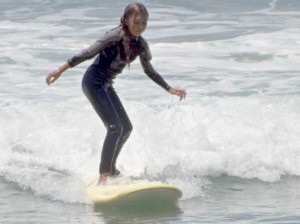Surfers learn to catch foam waves before they can move to real waves. One of the biggest problems beginner surfers have is the timing of foam waves. What they often don’t learn without lessons are the fundamentals necessary before catching waves.

Proper Position on the Surf Board
A surfer has to be on the board properly before paddling for waves. Feet have to be at the tail. The body has to be straight as a pencil with the the surfers nose in the middle of the board. Many surfers are crooked and too far forward before they begin.
Paddling has to be fast and even with short strokes. Most beginners start with slow strokes thinking the wave will push them. They don’t realize they have to get in front of the wave as it begins to push them or it over whelms them. Strokes too slow or with uneven effort will cause the board to turn in the wave and flip.
Timing to Catch the Foam Wave
Most beginners act like the surf board is a boogie board and jump on a few seconds before it arrives. Surfers need to paddle 20 feet before the wave arrives to build momentum and get balance and then paddle hard when the wave is 5 feet from the board. Then, most important, the surfer paddles three or four times hard after the wave hits the board.
Patience is Required
Most beginners are putting their hands on the board just as the wave hits it. At this time, the wave has the tail lifted and the nose of the board pointed down. The surfer puts their hands on the board right away and causes the nose to go under water (pearling). They have to paddle until the board is in front of the wave and the nose comes up.
Once the surfer learns these fundamentals, it is much easier to learn to ride real waves. Watch surfers on real waves time by waiting for the wave to come under them, paddling hard, and then putting their hands on the board for a smooth pop up.
For Oceanside Surf Lessons, see the Home Page
For my Dry Land and in Water Demo video